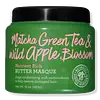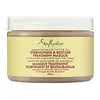What's inside
What's inside
 Key Ingredients
Key Ingredients

 Benefits
Benefits

 Concerns
Concerns

 Ingredients Side-by-side
Ingredients Side-by-side

Water
Skin ConditioningCetearyl Alcohol
EmollientStearyl Alcohol
EmollientDiheptyl Succinate
EmollientCapryloyl Glycerin/Sebacic Acid Copolymer
Skin ConditioningParfum
MaskingBehentrimonium Chloride
PreservativePrunus Amygdalus Dulcis Oil
Skin ConditioningHydrogenated Vegetable Oil
EmollientCamellia Sinensis Leaf Powder
ExfoliatingMalus Domestica Fruit Extract
AntioxidantLeuconostoc/Radish Root Ferment Filtrate
AntimicrobialDistearyldimonium Chloride
PPG-3 Benzyl Ether Ethylhexanoate
EmollientPhenoxyethanol
PreservativeEthylhexylglycerin
Skin ConditioningGlycerin
HumectantQuaternium-80
Hydroxyethylcellulose
Emulsion StabilisingCitric Acid
BufferingWater, Cetearyl Alcohol, Stearyl Alcohol, Diheptyl Succinate, Capryloyl Glycerin/Sebacic Acid Copolymer, Parfum, Behentrimonium Chloride, Prunus Amygdalus Dulcis Oil, Hydrogenated Vegetable Oil, Camellia Sinensis Leaf Powder, Malus Domestica Fruit Extract, Leuconostoc/Radish Root Ferment Filtrate, Distearyldimonium Chloride, PPG-3 Benzyl Ether Ethylhexanoate, Phenoxyethanol, Ethylhexylglycerin, Glycerin, Quaternium-80, Hydroxyethylcellulose, Citric Acid
Water
Skin ConditioningCetearyl Alcohol
EmollientCocos Nucifera Oil
MaskingGlycerin
HumectantButyrospermum Parkii Butter
Skin ConditioningStearyl Alcohol
EmollientCetyl Alcohol
EmollientBehentrimonium Methosulfate
Parfum
MaskingBehentrimonium Chloride
PreservativePanthenol
Skin ConditioningHydrolyzed Wheat Protein
Skin ConditioningHydrolyzed Wheat Starch
Skin ConditioningCetrimonium Chloride
AntimicrobialPersea Gratissima Oil
Skin ConditioningMangifera Indica Seed Butter
Skin ConditioningOlea Europaea Fruit Oil
MaskingRicinus Communis Seed Oil
MaskingMentha Piperita Leaf Extract
Skin ConditioningMauritia Flexuosa Fruit Oil
Skin ConditioningYeast Extract
Skin ConditioningHydrolyzed Keratin
HumectantMacadamia Ternifolia Seed Oil
EmollientTocopherol
AntioxidantNiacin
SmoothingAloe Barbadensis Leaf Juice
Skin ConditioningAcetic Acid
BufferingHydrogenated Vegetable Oil
EmollientGlycine Soja Oil
EmollientTrifolium Pratense Flower Extract
AstringentCaramel
Cosmetic ColorantPropanediol
SolventCaprylhydroxamic Acid
Caprylyl Glycol
EmollientBenzoic Acid
MaskingWater, Cetearyl Alcohol, Cocos Nucifera Oil, Glycerin, Butyrospermum Parkii Butter, Stearyl Alcohol, Cetyl Alcohol, Behentrimonium Methosulfate, Parfum, Behentrimonium Chloride, Panthenol, Hydrolyzed Wheat Protein, Hydrolyzed Wheat Starch, Cetrimonium Chloride, Persea Gratissima Oil, Mangifera Indica Seed Butter, Olea Europaea Fruit Oil, Ricinus Communis Seed Oil, Mentha Piperita Leaf Extract, Mauritia Flexuosa Fruit Oil, Yeast Extract, Hydrolyzed Keratin, Macadamia Ternifolia Seed Oil, Tocopherol, Niacin, Aloe Barbadensis Leaf Juice, Acetic Acid, Hydrogenated Vegetable Oil, Glycine Soja Oil, Trifolium Pratense Flower Extract, Caramel, Propanediol, Caprylhydroxamic Acid, Caprylyl Glycol, Benzoic Acid
Ingredients Explained
These ingredients are found in both products.
Ingredients higher up in an ingredient list are typically present in a larger amount.
This ingredient is a preservative and often used for it's anti-static properties. You'll most likely see this ingredient in hair conditioners.
It does not cause irritation or sensitization in leave-on products at 1-5%.
Cetearyl alcohol is a mixture of two fatty alcohols: cetyl alcohol and stearyl alcohol. It is mainly used as an emulsifier. Emulsifiers help prevent the separation of oils and products. Due to its composition, it can also be used to thicken a product or help create foam.
Cetearyl alcohol is an emollient. Emollients help soothe and hydrate the skin by trapping moisture.
Studies show Cetearyl alcohol is non-toxic and non-irritating. The FDA allows products labeled "alcohol-free" to have fatty alcohols.
This ingredient is usually derived from plant oils such as palm, vegetable, or coconut oils. There is debate on whether this ingredient will cause acne.
Due to the fatty acid base, this ingredient may not be Malassezia folliculitis safe.
Learn more about Cetearyl AlcoholGlycerin is already naturally found in your skin. It helps moisturize and protect your skin.
A study from 2016 found glycerin to be more effective as a humectant than AHAs and hyaluronic acid.
As a humectant, it helps the skin stay hydrated by pulling moisture to your skin. The low molecular weight of glycerin allows it to pull moisture into the deeper layers of your skin.
Hydrated skin improves your skin barrier; Your skin barrier helps protect against irritants and bacteria.
Glycerin has also been found to have antimicrobial and antiviral properties. Due to these properties, glycerin is often used in wound and burn treatments.
In cosmetics, glycerin is usually derived from plants such as soybean or palm. However, it can also be sourced from animals, such as tallow or animal fat.
This ingredient is organic, colorless, odorless, and non-toxic.
Glycerin is the name for this ingredient in American English. British English uses Glycerol/Glycerine.
Learn more about GlycerinHydrogenated Vegetable Oil is created by adding hydrogen to vegetable oil in order to give it more stability. This process also raises the melting point of vegetable oil. In cosmetics, it is an emollient.
Emollients help soothe and soften the skin. They do this by creating a protective film on your skin. This barrier helps trap moisture and keeps your skin hydrated. Emollients may be effective at treating dry or itchy skin.
The term "Hydrogenated Vegetable Oil" is an umbrella term and can refer to a variety of vegetable oils and blends of: sunflower oil, soybean oil, olive oil, coconut oil, palm oil, and more.
Due to the differences in vegetables, the benefits may vary.
Learn more about Hydrogenated Vegetable OilParfum is a catch-all term for an ingredient or more that is used to give a scent to products.
Also called "fragrance", this ingredient can be a blend of hundreds of chemicals or plant oils. This means every product with "fragrance" or "parfum" in the ingredients list is a different mixture.
For instance, Habanolide is a proprietary trade name for a specific aroma chemical. When used as a fragrance ingredient in cosmetics, most aroma chemicals fall under the broad labeling category of “FRAGRANCE” or “PARFUM” according to EU and US regulations.
The term 'parfum' or 'fragrance' is not regulated in many countries. In many cases, it is up to the brand to define this term.
For instance, many brands choose to label themselves as "fragrance-free" because they are not using synthetic fragrances. However, their products may still contain ingredients such as essential oils that are considered a fragrance by INCI standards.
One example is Calendula flower extract. Calendula is an essential oil that still imparts a scent or 'fragrance'.
Depending on the blend, the ingredients in the mixture can cause allergies and sensitivities on the skin. Some ingredients that are known EU allergens include linalool and citronellol.
Parfum can also be used to mask or cover an unpleasant scent.
The bottom line is: not all fragrances/parfum/ingredients are created equally. If you are worried about fragrances, we recommend taking a closer look at an ingredient. And of course, we always recommend speaking with a professional.
Learn more about ParfumStearyl Alcohol is a type of fatty alcohol from stearic acid. It is a white, waxy compound used to emulsify ingredients.
Fatty Alcohols are most often used as an emollient or to thicken a product. Emollients help soothe and hydrate the skin by trapping moisture.
They are usually derived from natural fats and oils and therefore do not have the same drying or irritating effect as solvent alcohols. FDA allows products labeled "alcohol-free" to have fatty alcohols.
Learn more about Stearyl AlcoholWater. It's the most common cosmetic ingredient of all. You'll usually see it at the top of ingredient lists, meaning that it makes up the largest part of the product.
So why is it so popular? Water most often acts as a solvent - this means that it helps dissolve other ingredients into the formulation.
You'll also recognize water as that liquid we all need to stay alive. If you see this, drink a glass of water. Stay hydrated!
Learn more about Water